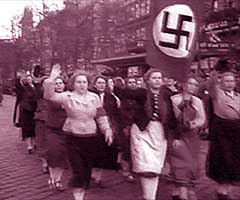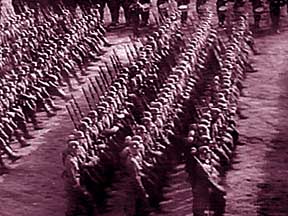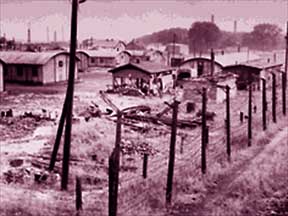|
|
|
||
 |
Until August 1934, President Hindenburg had the power to dismiss Adolf Hitler from the post of chancellor. When Hindenburg died in that month, Hitler was able to unite the offices of Chancellor and President and to adopt the new title of "Fuhrer" or Leader. From then on in Hitler was in total control of Germany. How did the lives of people change in Nazi Germany? How did Hitler control Germany? What happened to Jews in Nazi Germany? |
| How did the lives of people change in Nazi Germany? |
The Nazis believed that individual people did not matter. What was important, they believed, was a strong central government. Individuals were forced to accept the roles given to them in society - women should be educated to become housewives and mothers, men should be educated to become workers and soldiers.
The biggest changes were in the lives of women and children: • Books of nursery rhymes were published which encouraged children to play with guns and enjoy fighting. Children's songs were about bloodshed, violence and anti-Semitism. • All schools were single sex and girls and boys were educated quite differently. Girls studied no foreign languages and the only maths and science they learnt was linked to cooking and childcare. This was all part of a deliberate plan to prevent women having careers. A woman could work until she got married, but she was then expected to give work up to become a housewife. • All school lessons were based on Nazi ideas. School textbooks were rewritten and included Nazi versions of German history. Maths problems involved calculations about bombing Poland and killing invalids. Children were taught Nazi beliefs everyday in subjects such as Ideology and Eugenics. • A woman's life was described as "Church, Children and Cooking". Women were discouraged from wearing make-up, smoking or buying expensive clothes. They were expected to allow their hair to grow and put in plaits or a bun. Physical fitness for all, both girls and boys was encouraged. • Women were expected to have at least four children. If they did they were given a medal every year on the birthday of Hitler's mother. This was called the "Mutterkreuz", the Mother's Cross. • Boys were educated differently. They studied science and mathematics and took part in a great deal of physical exercise. • There was a lot of propaganda about the ideal German family. Photographs and posters showed the woman looking after the children and the man going out to work and protecting the wife. • All children had to join Nazi youth organisations by 1939. The Nazis realised that it was very important for them to win over children. They joined at the age of five and stayed until eighteen. Boys joined the Pimpfen, then the German Youth and then the Hitler Youth. Girls joined the League of German Maidens. • Children took part in "fun" activities - camping, sports, outings; but they also had lectures about National Socialism and Nazi ideas. The meetings were in the evenings and at weekends. Girls found that they had little time for homework. This was to prevent them having a career. It also meant that children had little spare time to pick up ideas that the Nazis did not approve of. Children were used to control their parents by being encouraged to report what they did and said. Hitler realised that older people would be less enthusiastic about his ideas, so he made every effort to win the minds of the next generation. • Men were forced to go into the Labour Service at the age of eighteen. This lasted for six months and was one of the methods that the Nazis used to cut unemployment In the Labour Service men worked building roads, digging ditches and reclaiming land. Most of the work was manual. This meant that they toughened up for the army. They lived in camps and marched to work every morning. They were only paid about 50 pence a week, but meals and accommodation were provided. • After Labour Service men went into the army for two years. Conscription was started for all Germans in 1935. • After military training there was plenty of work. In 1933 unemployment in Germany stood at 6,000,000; by 1938 it was 500,000 and by 1939 it had virtually disappeared. This was one of the most important reasons why most Germans accepted Hitler's ideas; he offered security after the Depression. • In fact the reduction in unemployment was deceptive. Many of the unemployed were absorbed into the Labour Service and the army. Most women were forced out of work and many projects, like the Autobahns, were built without machinery. This meant that more workers were needed. • Workers found that their rights at work were taken away. Trade Unions were banned and were replaced by the Nazi Labour Front. This organised festivals and demonstrations. There were other organisations which workers could join, such as "Strength through Joy", which organised activities and outings. Workers were also offered cheap subsidised holidays; a week's cruise for a family cost £7.00. | |
 |
||
| Back to top |
| How did Hitler control Germany? |
Most Germans seem to have accepted Hitler's ideas, but for those who did not life could be unpleasant:
• All other political parties were banned. The leaders of the Communist and Socialist parties were arrested and put in Concentration Camps. The first of these were opened in 1933. The Reichstag ceased to have any importance. • Only Nazis could become civil servants, government officials or teachers. • A People's Court was set up to try cases of treason, but this could include almost anything. It worked in secret and there was no means to appeal, except to Hitler himself. • The Nazi Party took control of every area of life in Germany. A secret police force was set up, the "Geheime Staats Polizei" (Gestapo). This was used to spy on people at all times. Germans learned to keep their mouths shut. Any sign of complaint could lead to arrest and "re-education" or to complete disappearance. In every block of flats there was a warden who checked on people's comings and goings. • The Nazis controlled all books and newspapers, films and radio programmes. Any writers, painters or composers that the Nazis did not approve of were banned. These included: Mendelssohn, a German composer who was Jewish; Van Gogh, a Dutch painter who was an impressionist; and H G Wells, a British novelist who wrote a book called "The Shape of Things to Come" in which he predicted that a Second World War would lead to the destruction of the world. Hitler realised that if he could control what people read, looked at and listened to he could control people's ideas. Most of the changes were introduced gradually; the worst effects only came into force during the Second World War. It was not until 1939 that Jews began to be really badly treated. At the same time most people found themselves becoming better off - wages rose, transport improved and there was more security and very little crime. Overall Germany seemed to be recovering. In 1936 the Olympic Games were held in Berlin and the Rhineland was reoccupied. | |
 |
||
| Back to top |
| What happened to Jews in Nazi Germany? |
Hitler believed that the Jews were responsible for Germany's defeat in the First World War. As soon as he came to power he began to attack them:
• From 1933 Jews were subjected to increasing persecution in Nazi Germany. At first they were banned from some professions - medicine, dentistry, the civil service, for example. They also found that their shops were boycotted from time to time. • Then in 1935 the Nuremberg Laws were announced - these made Jews second class citizens and prevented them from marrying non-Jews. They also lost the right to vote and had to use separate seats in buses and parks which were painted yellow. • In 1938, Jewish synagogues, shops and houses all over Germany were attacked. This was known as Crystal Night. It took place after a Nazi was murdered by a Jew in Paris. 30,000 Jews were arrested, although most were released soon after. A fine of 1,000,000,000 marks was levied on Jews in Germany for the repair of the damage. From early 1939 Jews were banned from owning businesses and were forced to wear a yellow Star of David on their clothing. The Nazis forced Jews out of Germany; many went to Britain, France and the USA. Once war broke out this became more difficult. Jews could not leave and were forced into Ghettos and then into Concentration Camps. Ghettos were areas of cities that were surrounded by fences. Jews were allowed out in the morning to work, but had to return before a curfew in the evening. In 1941 Hitler invaded the USSR, where there were millions more Jews. Death Squads, "Einsatzgruppen", were set up to shoot Jews at will. Finally the Nazis decided in January 1942 to set up Extermination Camps. This became known as the Final Solution. They intended to murder all of the Jews in Europe: • Altogether at least 6,000,000 Jews were killed by the Nazis, along with more than 1,000,000 gypsies and 4,000,000 Soviet prisoners of war. Many Germans were unaware of what was happening. Extermination Camps like Auschwitz and Treblinka were built outside of Germany. The true story was only discovered when the Allies advanced across Europe in 1945. • Many prisoners of war and Jews were worked to death in Concentration Camps, such as Belsen and Dachau in Germany. These were certainly known about and many German businesses used Jewish workers in their factories. • The evidence given at the trials of the camp commandants was horrific. Rudolf Hoess, the commandant of Auschwitz, described how he tried to find the most efficient poison gas to kill the inmates of his camp, whom he thought were nothing better than vermin. • Survivors described how the fittest inmates were allowed to live to be used as slave labour. The old, sick and young were all murdered. Altogether between 6,000,000 and 12,000,000 people died. This mass murder has become known as the Holocaust, the Hebrew word for sacrifice. | |
 |
||
| Back to top |